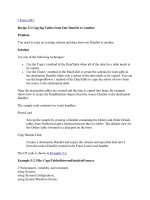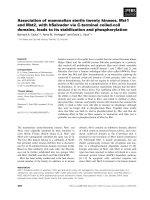Inventions one good thing leads to another
Bạn đang xem bản rút gọn của tài liệu. Xem và tải ngay bản đầy đủ của tài liệu tại đây (2.37 MB, 8 trang )
Reader
Inventions: One
Good Thing Leads
To Another
Genre
Expository
Nonfiction
Build Background
Access Content
Extend Language
• Inventions
• Civilization
• Simple
Machines
• Diagrams
• Captions
• Labels
• Time Line
• Context Clues
• Suffix -or
Scott Foresman Reading Street 4.4.3
ì<(sk$m)=becaea< +^-Ä-U-Ä-U
ISBN 0-328-14204-2
by Hiro Takahashi
Illustrated by Bruce Day
Talk About It
1. Where do inventors get their ideas?
2. Which inventions in this book do you use? Do you
find them useful? How?
Inventions: One
Good
Write About
It Thing Leads
3. A cause-effect diagram shows how one event
To
Another
makes another
event
happen. Here is a cause and
the effect for using a lever.
I push down
on one end.
The other
end goes up.
Make cause-effect diagrams on a separate paper,
and write causes and effects for two inventions,
such as a piano and a computer or a telephone.
Extend Language
The suffix -or can be added to verbs to make
new words: conduct + or = conductor. (A railroad
conductor can conduct, or guide, people on a train.)
What is the word for a person who invents things?
Photographs
Every effort has been made to secure permission and provide appropriate credit for photographic material. The
publisher deeply regrets any omission and pledges to correct errors called to its attention in subsequent editions.
Cover ©Getty Images; 1 ©DK Images; 2 ©Getty Images; 5 (TL) ©DK Images; 6 (TR)
©Dave King/DK Images; 8 ©DK Images; 9 (T) ©Corbis, (CR) ©Photo Researchers, Inc;
10 (T) ©Corbis, (BR) ©Getty Images; 11 ©Getty Images; 12 ©Getty Images.
by Hiro Takahashi
Illustrated by Bruce Day
Copyright © Pearson Education, Inc.
ISBN: 0-328-14204-2
All Rights Reserved. Printed in the United States of America.
This publication is protected by Copyright, and permission should be obtained from
the publisher prior to any prohibited reproduction, storage in a retrieval system,
or transmission in any form by any means, electronic, mechanical, photocopying,
recording, or likewise. For information regarding permission(s), write to: Permissions
Department, Scott Foresman, 1900 East Lake Avenue, Glenview, Illinois 60025.
Editorial Offices: Glenview, Illinois • Parsippany, New Jersey • New York, New York
Sales
Massachusetts
• Duluth,
Georgia • Glenview, Illinois
1234
5 6 7Offices:
8 9 10 Needham,
V0G1 14 13
12 11 10 09 08
07 06 05
Coppell, Texas • Sacramento, California • Mesa, Arizona
Have you ever heard about an amazing new
invention? You might say, “Who thought of that
wonderful idea? That person is a genius!”
Inventors are amazing people. They think
outside the box. They work hard at something
for a long time. Their names go down in history.
Where do inventors get their ideas? Often, an
invention starts with an idea someone had a long
time ago.
[Art: Stunning
stock photo of an
up-to-the-minute
compact laptop PC
Let’s look at the
invention of the
lever, for example.
Some time
back in the past,
hunters used poles
to lift a heavy
animal onto a skin
and drag it home.
Another person
thought of a way
to lift a friend to
pick fruit.
Such things probably happened hundreds of
times—all over the world. All these prehistoric
people used levers. We just don’t know what
they called their “invention.”
outside the box: differently from other people
go down in history: are remembered for a long, long
time
2
prehistoric: long, long ago, before people wrote things
down
3
effort
lever
load
load
Levers work by
pushing or pulling. A
person pushes down one
end of the lever, and
that effort lifts or moves
a load on the other
end. Here, the gardener
pushes vigorously (the
effort) on the shovel (the
lever), and the other end
of the lever lifts the dirt
(the load).
effort
lever
levers
Many hundreds of years after prehistoric
people first used levers, a Greek man wrote
about them. He understood what they could
do, and he taught other people how to use
them. The man’s name was Archimedes
(ark uh ME deez), and he lived about 2,200
years ago!
Because Archimedes described this simple
tool, he is sometimes called the inventor of the
lever. He was not the first person to use a lever,
but his explanations helped others find new ways
to use it.
fulcrum
A pair of scissors has two levers attached at
a fulcrum in the middle. Pull the handles apart,
and the sharp ends of the lever move apart.
Push the handles together, and the sharp ends
move together. The sharp ends of the lever
(the blades) cut the paper.
vigorously: in a strong way
fulcrum: the support on which a lever moves
4
5
inside the
piano
The lever might seem
simple today. But this
simple machine is part
of thousands of later
inventions, including
simple ones like scissors
keys
and not-so-simple ones like
pianos. One good thing
leads to another.
Look inside a grand
piano. There are many levers. Your finger
provides the effort. That effort pushes a piano
key (one end of a lever) down. As the other end
of the lever raises up, it pushes up another lever
(the load). Inside the piano, levers keep pushing
or pulling one another until finally, a soft, little
hammer (another lever) strikes a wire. Wow! You
have music!
wire
hammer
strikes
wire
finger
pushes key
down
levers
raise up
6
Let’s take a look at another invention: the
personal computer or PC. Today, scientists use PCs
to do difficult math problems. Who invented the
PC? Let’s start at the beginning. To do that, we
need to go back 5,000 years!
Even 5,000 years ago, people used math. A
farmer needed to know how many crops to trade
for a sheep. A peasant, or poor farmer, needed
to know how many bricks to use for a wall.
In Babylonia (modern-day Iraq) people dug
lines into sand or dirt and put pebbles in them.
They did calculations by moving pebbles from
one line to another. This worked well, unless a
dust storm blew the sand away.
pebbles: very small rocks
7
frame
Eventually,
someone thought of
making a calculating
device that the wind
stick
wouldn’t blow away.
The abacus (A buh
kus) was invented.
Who invented it? We
don’t know. People
used an abacus in
Egypt about 2,500
bead
years ago. A little later,
it was used in China,
and it is still widely
used there today.
An abacus has beads on sticks or wires inside a
frame. You do calculations by moving the beads.
The Aztecs in Mexico used an abacus
sometime around the year 900. Their abacus used
dry corn instead of beads.
Extend Language
Context Clues
Context clues help you learn the meaning of a
new word. Context clues are the other words and
sentences surrounding a word. Context clues may be
in the same sentence, in the same paragraph, or in
the same article.
Read pages 7 and 8 again. Look for context clues
for the word calculations. What does the word
calculations mean? How did the context clues help
you learn the word’s meaning?
view from above
Calculating machine, invented in Germany by
Gottfried Wilhelm Leibniz in 1671
view from below
In the 1600s,
people invented
new kinds of
calculators. These
inventions were
quite different
from the abacus.
Arithmetic machine, invented in
And each new
France by Blaise Pascal in 1642
calculator was
more powerful
than the earlier one. These early calculators
helped pave the way for computers.
pave the way for: prepare people for
8
9
Many things have their roots in earlier
inventions or earlier ideas. Let’s look at one
more example. Today, many people wear contact
lenses to improve their sight. Adolf Eugen Fick
invented them in 1887, but there’s more to the
story. Look at this time line.
1000
Pieces of glass were set on
written words to make them
look bigger
1508
Leonardo da Vinci draws
pictures of the idea of contact
lenses in Italy
1636
René Descartes draws pictures
of contact lenses in France
1262
In England, Roger Bacon
experiments with lenses to
make things look bigger
The first true computer, called ENIAC, was finished in
1946. It filled a whole room.
The first true computer was built for the
United States Government in 1946. It was so big
that people could walk around inside it! And
they had to, to make it work.
By the 1970s, computers were small enough to
pick up and carry. Today, most schoolrooms and
homes in the United States have computers.
People will tell you
that computers were
invented in the late
1900s. Actually, the
invention took more
than 5,000 years! It
took time, but one
good thing did lead
to another.
1268– Alessandro di Spina
1280 introduced eyeglasses in
Italy, but they were used
in China at this time, too
1784
Benjamin Franklin invents
bifocal lenses in Massachusetts
1887
Adolf Eugen Fick fits contact
lenses on animals and people
in Germany
1970s Soft contact lenses are
invented in the United States
have their roots in: come from; were inspired by
bifocal lenses: two-part lenses with one part for reading
and one part for seeing far away
10
11
Talk About It
1. Where do inventors get their ideas?
2. Which inventions in this book do you use? Do you
find them useful? How?
Write About It
3. A cause-effect diagram shows how one event
makes another event happen. Here is a cause and
the effect for using a lever.
I push down
on one end.
The other
end goes up.
Make cause-effect diagrams on a separate paper,
and write causes and effects for two inventions,
such as a piano and a computer or a telephone.
Extend Language
The suffix -or can be added to verbs to make
new words: conduct + or = conductor. (A railroad
conductor can conduct, or guide, people on a train.)
What is the word for a person who invents things?
Photographs
Every effort has been made to secure permission and provide appropriate credit for photographic material. The
publisher deeply regrets any omission and pledges to correct errors called to its attention in subsequent editions.
Cover ©Getty Images; 1 ©DK Images; 2 ©Getty Images; 5 (TL) ©DK Images; 6 (TR)
©Dave King/DK Images; 8 ©DK Images; 9 (T) ©Corbis, (CR) ©Photo Researchers, Inc;
10 (T) ©Corbis, (BR) ©Getty Images; 11 ©Getty Images; 12 ©Getty Images.
Inventions make our work easier. Sometimes,
they change the way we live. Everything
from levers to contact lenses, from shovels to
computers, from scissors to grand pianos was
invented. Almost every time, the inventor built
on earlier ideas. One good thing led to another.
What would you like to invent?
12
ISBN: 0-328-14204-2
Copyright © Pearson Education, Inc.
All Rights Reserved. Printed in the United States of America.
This publication is protected by Copyright, and permission should be obtained from
the publisher prior to any prohibited reproduction, storage in a retrieval system,
or transmission in any form by any means, electronic, mechanical, photocopying,
recording, or likewise. For information regarding permission(s), write to: Permissions
Department, Scott Foresman, 1900 East Lake Avenue, Glenview, Illinois 60025.
1 2 3 4 5 6 7 8 9 10 V0G1 14 13 12 11 10 09 08 07 06 05









